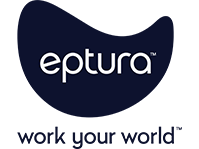
Hybrid work has reshaped how people use the office, but the trend is now shifting towards more in-person time. According to Eptura’s 2025 Workplace Index, 34% of businesses plan to increase office attendance requirements. While this signals a move toward a more office-centric culture, it intensifies a significant challenge: the midweek mountain.
Instead of showing up five days a week, most employees cluster their in-office days from Tuesday to Thursday. This pattern creates a peak demand for desks, meeting rooms, and collaboration spaces that many companies, especially those that have downsized their real estate, struggle to accommodate.
When employees commute to the office only to find they can’t locate a desk near their teammates or have their bookings canceled at the last minute, productivity drops, and frustration rises.
Key takeaways
- Desk sharing hybrid workplaces help reduce costs and improve efficiency. By matching desk availability with real demand, organizations eliminate wasted space, cut real estate expenses, and ensure resources scale with workforce needs
- Employees use flexible desk booking software to help flatten the midweek mountain. With features like team neighborhoods, booking windows, split-day reservations, and demand balancing distribute occupancy evenly across the week and ensure employees can always find a desk that meets their needs
- Implementation requires planning, policy, and analytics. Leaders succeed when they design clear rules, communicate early with employees, and use utilization data to refine desk allocation strategies. The right booking technology makes these processes seamless and sustainable
Desk sharing in the hybrid workplace gives leaders the tools to smooth these spikes. By replacing permanently assigned seating with a booking system, organizations create a more flexible environment.
Employees reserve workstations as needed, teams secure designated areas for collaboration, and space managers utilize real-time data to optimize occupancy. The result, employees spend less energy worrying about where they’ll sit and more time focusing on their work.
Benefits of desk sharing in hybrid workplaces
Shifting from fixed seating to desk sharing hybrid workplace creates measurable, long-term advantages that go well beyond saving space.
Lower real estate costs
In a traditional office, many desks sit empty on Mondays and Fridays. Desk sharing eliminates that waste by aligning the number of workstations with actual demand. Instead of paying for square footage that’s underutilized, organizations can right-size their layouts and avoid leasing extra space. Studies show that companies implementing desk sharing can reduce their office footprint by up to 30%.
Efficiency gains
When managers link occupancy data to building systems, they reduce unnecessary energy consumption. Heating, cooling, and lighting adjust to match the desks actually in use. This not only cuts operational costs but also supports corporate sustainability goals. By trimming waste on a day-to-day level, desk sharing contributes to broader initiatives and demonstrates environmental responsibility.
Employee choice
One of the biggest wins for employees is freedom. Instead of being tied to a single desk, they can choose the right seat for their needs. A quiet area for heads-down focus, a desk near a project team, or a spot closer to collaboration spaces—all become options. This sense of autonomy is a major driver of employee satisfaction. In fact, companies with successful desk sharing programs report a 25% increase in employee satisfaction score.
Stronger collaboration
When offices rely on permanent desks, teams often drift apart as seating assignments change over time. Desk sharing flips the model. Shared neighborhoods allow project groups or departments to stay close together during peak days. Employees know they’ll sit near colleagues working on the same goals, which strengthens team cohesion and encourages spontaneous collaboration.
Scalability
A flexible desk strategy adapts to change in ways static layouts can’t. Organizations can scale up to accommodate contractors during a large project or scale down if headcount decreases. Policies and booking systems adjust faster than physical renovations, making desk sharing a practical choice for workplaces that need to stay nimble.
Together, these benefits highlight why hybrid workspace planning isn’t only about squeezing more people into the same space. It’s about creating an environment where employees thrive, operations run leaner, and the organization stays ready for what comes next.
Solving office peak days with smarter desk allocation
The midweek mountain, when most employees come into the office Tuesday through Thursday, creates a real challenge. Without controls, these peak days overwhelm the space, while Mondays and Fridays remain underused. A desk booking system with built-in rules helps balance the load and keeps occupancy manageable.
Team neighborhoods
Leaders can assign specific zones of desks to departments or project teams. This ensures that employees working on the same initiatives remain close to each other, even on high-demand days. By reducing the scramble to find nearby seats, neighborhoods support collaboration while eliminating unnecessary stress.
With AI-powered insights, workplace leaders can see when teams are most likely to come in together and recommen “Team days” to align schedules. This way, neighborhoods don’t just group people by department, they actively encourage in-person collaboration on the right days.
When combined with smart booking, AI helps managers anticipate midweek peaks, guide employees to available spaces, and keep neighborhoods balances across the week.
Booking windows
Clear rules around when employees can reserve desks prevent early booking and hoarding. For example, limiting reservations to two weeks in advance keeps access open for everyone, not just the planners. Booking windows create fairness, especially during midweek peaks when demand is highest.
Split-day reservations
Some employees may only need the office for part of the day—morning deep work, an afternoon client meeting, or a few hours of team collaboration. Split-day bookings allow them to reserve a desk for AM or PM sessions. This doubles capacity without adding physical desks and provides flexibility for different work styles.
Demand balancing
Occupancy data makes it clear which days fill up fastest. With that insight, leaders can apply rules that encourage employees to spread attendance more evenly. For example, if Wednesday consistently reaches capacity, policies can limit Wednesday bookings once a threshold is met or incentivize employees to choose Monday or Friday with rewards such as early meeting-free mornings, flexible end-of-day schedules, or reconginition programs for balanced attendance.
Colleague search
Desk booking works best when employees can easily locate and sit near teammates. A colleague search function lets workers find and reserve desks near project partners, mentors, or direct reports. This feature addresses one of the biggest anxieties in desk sharing: sitting too far away from the people who matter most.
When leaders combine these flexible desk policies with strong booking technology, they create a system employees trust. Instead of worrying about whether they’ll find a seat during midweek crowding, employees walk into the office confident they’ll have a desk that fits their needs.
How to implement desk sharing in hybrid workplaces
Rolling out a desk sharing hybrid workplace isn’t just a matter of swapping fixed desks for shared ones. Success depends on a deliberate strategy backed by the right technology.
Leaders need to combine policy, communication, and data to create an environment employees trust and want to use. That means setting clear rules, giving employees simple booking tools, and continuously optimizing based on utilization insights.
To put desk sharing into practice and avoid common pitfalls, leaders should follow these steps.
1. Assess workplace needs
Audit existing space, occupancy levels, and patterns of use. Identify high-demand zones and days with low attendance. This data sets a baseline for planning.
2. Design desk allocation policies
Decide how to group teams, define neighborhoods, and set booking limits. Policies should prioritize fairness, collaboration, and productivity.
3. Communicate with employees
Launch a clear communication campaign before rollout. Show how booking works, outline the rules, and highlight the benefits for employees. Early involvement reduces resistance and improves adoption.
4. Deploy booking technology
Choose a system that supports mobile reservations, desktop access, and in-office kiosks. Employees should be able to reserve, cancel, or adjust bookings quickly from any device.
5. Monitor and refine with analytics
Use utilization reports to see how policies perform. If certain areas sit empty or bookings pile up midweek, adjust rules to spread occupancy more evenly.
6. Provide ongoing support
Train managers to answer employee questions, troubleshoot common issues, and reinforce booking best practices. Consistent support ensures the system continues to deliver results.
Building a smarter, more flexible workplace
Desk sharing works best when it combines flexible policies, employee choice, and real-time analytics. Leaders create balance by matching supply to demand, distributing attendance across the week, and empowering employees with clear rules.
Instead of overwhelming the office on Wednesdays, employees spread out, secure reliable seating, and collaborate where it matters most. For workplace leaders, the payoff is twofold with fewer wasted desks and happier, more productive teams.
Learn more about how Eptura’s desk booking software helps balance demand and create a seamless hybrid experience.





